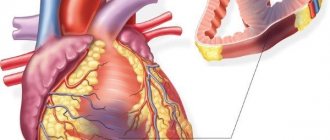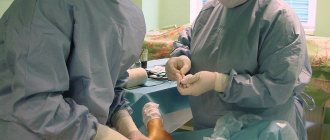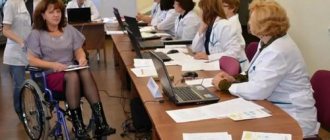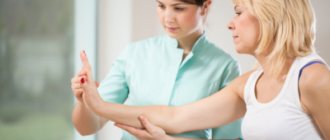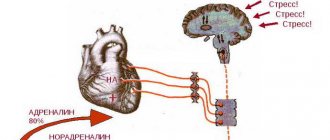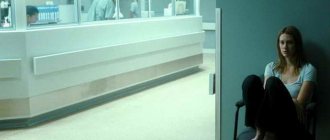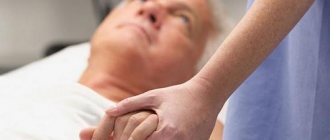Stroke is a disease from which no one is immune. A blood vessel in the brain can become clogged (cerebral infarction - 80%) or rupture (hemorrhage - 20%). Subsequently, the blood supply to the brain tissue (depending on which vessel and where the stroke occurred) stops, and it dies. About 2 million cells die every minute; The longer a person does not receive help, the more cells die and the stronger the brain damage (impaired motor, speech abilities, memory, balance). In the worst case - if it is impossible to provide assistance or it is delayed - death occurs.
Is it possible to suffer a stroke on the legs due to such serious manifestations of the condition? Yes. There is such a thing as a microstroke. But it can cause more damage than it seems. The usual test used to initially diagnose a stroke is not accurate in this case. Sometimes complications such as cognitive defects go unnoticed.
Concept
More than 4 out of 10 patients hospitalized with symptoms of a ministroke experience mild cognitive impairment. New research shows that these defects are not recognized by standard tests.
The results, presented by Canadian scientists on February 24, 2010 at the International Stroke Conference in San Antonio, Texas, show that the effects of stroke include loss of the ability to process abstract ideas, think things through, and make quick calculations. Doctors call these abilities "executive functions."
“Regular” strokes are caused by blocked blood vessels in the brain, visible on MRI or CT scans. Signs of a microstroke suffered on the legs in men and women are very difficult to detect both during examination and when assessing the signs. It causes minor damage.
Some scientists consider the name “ministroke” to be a misnomer. A more correct term is “transient ischemic attack”, TIA (English: transient ischemic attack, TIA).
Causes
TIA (ICD-10 code G45.9) is a condition that can be called a “temporary stroke” because its symptoms disappear within 24 hours of the onset of the disease. The disorder is caused by severe acute defects in certain parts of the brain. Most often we are talking about embolization of a piece of coagulated blood in an artery, leading to a narrowing of the lumen. TIA is a short-term condition that resolves after restoration of blood flow in all arterial branches. Consequently, a person may not notice or pay much attention to stroke symptoms in the legs.
Causes of microstroke:
- atherosclerosis;
- cardiovascular diseases;
- high blood pressure;
- frequent migraines;
- high cholesterol;
- diabetes;
- overweight;
- smoking;
- lack of movement, physical activity;
- excessive consumption of alcoholic beverages.
How to learn to use a walker
As soon as the patient learns to stand confidently on his feet without support, he can begin to take his first steps. You can’t do this without an assistant, since he must belay from the paralyzed side to prevent a fall.
The patient should place the assistant's hand on the neck and rest his knee on the assistant's knee. Having fixed the joint, you can take the first step.
The assistant’s task is not only to support the patient, but also to control the correctness of his gait. When the patient moves with the help of a walker, it is necessary to ensure that the placement of the foot, rotation of the knee and hip joint are correct.
The whole process has several features:
- The patient cannot fully grasp the assistant's hand, since it is weakened.
- To take a step, he needs to throw his leg forward, which leads to the helper's leg catching.
- It is much more convenient to support the patient from a healthy part of the body, but the knee joint will not be fixed and the patient will not be able to hold on to the wall with his healthy hand.
The main purpose of using a walker is to gain the ability to bend the leg in all joints, otherwise the patient will constantly cling to the floor with his foot. The assistant should remind the person that the leg should be raised higher and bent at all joints.
High boots that fix the ankle joint will help facilitate movement. The affected arm should be secured with a scarf so that it does not sag during movement and the head of the humerus does not come out of the socket. During exercise, you should monitor the patient’s heart function and give him rest.
Read also: How does a person feel after a stroke?
Once the patient can move with the help of a walker without assistance, he or she can begin to walk independently. This is done with the help of a cane, holding on to the walls, moving a chair in front of you. But it is important to ensure that the load is evenly distributed. You cannot spare the sore leg by relying more on the healthy one.
The most common symptoms of a mini-stroke
The manifestations of a mini-stroke can vary greatly. They depend on the part of the brain affected. In the case of TIA, the following disorders often occur:
- weakness of the facial muscles - a person cannot smile, take air into his mouth, etc.;
- decreased muscle strength in the limbs – especially the arms;
- problems with speech – sometimes the ability to speak disappears, sometimes to express oneself.
But this does not mean that a stroke in the legs is necessarily associated with these symptoms. Any signs of possible acute brain injury should prompt immediate medical attention.
Blurred vision, loss of vision
The first organ that indicates a possible micro-stroke is the eyes. The disease may affect one or both eyes. About 44% of people who had a stroke had varying degrees of vision problems.
Dizziness
Dizziness is a common symptom of a mini-stroke under the age of 45. This is a clear sign that you need to see a doctor. Ignoring this symptom often leads to a major stroke.
Problems with speech and understanding
Throughout the day, almost everyone sometimes experiences a little confusion that they don't even notice. As a result, he may behave and speak a little “outside the norm.” But if you notice these abnormalities, or someone warned you about them, consult your doctor.
Loss of balance, problems walking
Symptoms of a ministroke include apathy and general weakness of the upper and lower extremities. Some people experience paralysis and subsequent collapse. Paralysis is a common symptom of a stroke and requires medical attention when it occurs. You can test for this symptom yourself.
Extend your arms in front of you, palms up, and stay in this position for 10 seconds. The fall of one arm indicates weakening of the muscles. It is recommended to consult a doctor.
Pain on one side of the face
A stroke is not always accompanied by pain. But tenderness in the limbs or one part of the face may indicate a TIA.
Headache and migraine
These symptoms are very common. The researchers found that stroke survivors with acute headaches were young and often suffered from migraines, especially if there was a family history of cerebral infarction.
Studies have shown that headaches and migraines as a manifestation of TIA are more common in women than in men. But this does not minimize the necessary caution when identifying such symptoms in representatives of the stronger sex.
Facial paralysis
This is one of the most common symptoms of a stroke. Usually only one part of the face is paralyzed.
Fatigue
According to several studies, women often experience fatigue, confusion and disorientation. Each of these symptoms is typical of a stroke.
Hiccups
This is an early sign of a micro-stroke suffered on the legs in women. The disorder affects the respiratory center of the brain, causing hiccups.
Breathing problems
Sudden stoppage or difficulty breathing is common in people who are developing a stroke. Cardiac arrhythmia due to lack of oxygen is also possible.
Sometimes it happens that the symptoms disappear before the ambulance arrives. But this is definitely not a reason to cancel a medical examination. Disorders of the cerebral arteries require examination; it is important to determine the cause of the disorder. In fact, TIA does not require specialized treatment because it will go away on its own. But it is necessary to examine the condition of the blood vessels supplying blood to the brain and, if necessary, eliminate defects. The incident may happen again, but with more serious consequences.
Massage treatment
To speed up the healing process and improve blood circulation in the brain, you can use massage. Foot massage after a stroke (and the whole body) is performed using:
- Stroking. With a relaxed palm they slide over the surface of the skin, collecting it into large folds. At first, the strokes should be superficial, but gradually their depth should be increased. They should capture fatty tissue and muscle. The specialist’s hand should move in a zigzag, spiral pattern. With this massage you can tone the body and, by removing the top layer of cells, improve blood circulation and tissue nutrition.
- Rubbing. This increases tissue elasticity and reduces swelling due to fluid movement. You need to rub the skin using your fingertips, the base of your palm, or your hand clenched into a fist.
- Kneading. This is a type of passive gymnastics. During the procedure, the muscle is grabbed, pulled, and compressed. There is also some effect on the blood vessels. Kneading helps increase the elasticity and tone of muscle fibers. Therefore, in the presence of spastic changes, the procedure is prohibited.
- Vibrations. The specialist performs oscillatory movements with a relaxed hand on the affected part of the patient’s body. The massage is performed at different speeds and amplitudes. Therefore, the result may be different. If the vibration is strong, then muscle tone decreases, and if it is high, it increases. Movements are usually performed from right to left.
Similar treatment can be carried out at home. It is carried out independently by loved ones, by hiring a specialist or using massagers.
Relatives of the victim should perform massage on the affected side, gradually moving to other areas. After a stroke, people only have:
- palmar surface, anterior part of the shoulder and forearm;
- pectoral muscle;
- the anterior surface of the thigh and the back of the lower leg;
- muscles of the sole.
These areas can only be massaged superficially, by stroking or lightly rubbing. For other areas, intense movements are suitable.
When massaging a patient in a supine position, you need to place a pillow under your head and a bolster under your knee. To prevent a healthy limb from moving, it can be secured with weights.
The process of recovery after a stroke is difficult and lengthy, but if the victim himself and his relatives make every possible effort, the result will be positive.
Awakened aneurysm
A cerebral aneurysm, that is, a bulge in a cerebral artery, is a fairly common occurrence. It looks like a sac in a weakened wall of a cerebral vessel. Doctors estimate that 2-3 people out of 100 have an aneurysm, but most of them do not know about it and do not experience any problems.
The danger arises when the bulge ruptures (hemorrhagic stroke) or simply enlarges (eg, due to high blood pressure, hardening of the arteries). Rupture occurs in an average of 1% of people with aneurysms per year and is more common with larger aneurysms. If it simply expands, it can begin to compress some of the nerve structures (most often the brain nerves) in its surroundings, causing their function to become impaired.
Bleeding from an aneurysm cannot be ignored. Unlike ischemic stroke, it usually results in a sudden, severe headache. Bleeding can occur at any time, most often after higher levels of physical activity, such as after a sporting event or during or after sex.
Hemorrhage should be treated immediately! If help is not given in a timely manner, a person may not survive a stroke.
Types of brain strokes
The following types of strokes are distinguished:
- Hemorrhagic. It causes hemorrhage in the brain tissue. The reason is a rupture of a vessel-artery against the background of increased pressure or weakness of the vascular wall. Symptoms develop rapidly: the face turns red, the head hurts unbearably, vomiting may begin, consciousness may become confused, and even limbs on one side of the body may be lost. Paralysis of the legs excludes the ability to move independently.
Ischemic stroke
- Ischemic - cerebral infarction. The risk group is elderly people with atherosclerotic processes in blood vessels. It develops as a result of blockage of the duct by a thrombus or a sharp narrowing of the wall of the vessel feeding the brain tissue. Symptoms of the condition: pain in the head, numbness of the limbs, severe dizziness, weakness to the point of fainting. A cerebral infarction may be accompanied by disturbances in speech, swallowing and a disorder of the visual analyzer.
- Subarachnoid hemorrhage is a rupture of an aneurysm of the vessels of the head. Manifestations: a feeling of a sharp blow to the occipital region, nausea to vomiting, motor agitation and a seizure state with confused consciousness.
Does a stroke happen that goes unnoticed and is suffered without hospitalization or medical intervention? Why does a patient sometimes ignore such severe symptoms and try to continue normal activities?
Nothing should be underestimated
If the symptoms described above appear, be sure to consult a doctor. The symptoms may subside within a few minutes. Despite the improvement in the condition, it is advisable to conduct an examination to diagnose or refute a mini-stroke.
Monitoring is carried out for at least 24 hours. After this, the diagnosis is either confirmed or not. If there are minimal changes indicating ischemia, a decision is made on what to do to prevent the development of a stroke.
Doctors are also ruling out another possible cause – epilepsy or migraine.
After discharge, to prevent the consequences of a micro-stroke suffered on the legs in women and men, it is important to eliminate the cause of the disorder as part of home treatment. The risk group includes people with hypertension, diabetes, atrial fibrillation, and atherosclerosis.
Therapy involves taking medications in the dosage prescribed by the attending physician.
Prevention
You can prevent TIA and reduce the risk of stroke by following a number of rules:
- Do not smoke.
- Monitor your blood pressure; if it is more than 120/80, see your doctor.
- Maintain a reasonable body weight.
- Control your cholesterol levels.
- If you have diabetes, follow your treatment and maintain the correct regimen.
- Move regularly - even walking can do wonders.
- If you have heart rhythm disturbances, do not underestimate the condition, follow your doctor's instructions.
TIA is a frequent warning about a disorder in the body or a health hazard. Although this is an unpleasant disorder, it can be viewed positively. This is a chance to change your life for the better. Addressing the cause of TIA and risk factors reduces the likelihood of a subsequent stroke by 40%.
